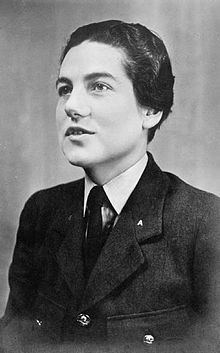Name Daphne Pearson | ||
 | ||
Full Name Joan Daphne Mary Pearson Books In War and Peace: the Life and Times of Daphne Pearson, GC | ||
Daphne Pearson (25 May 1911, Bournemouth – 25 July 2000, Melbourne) was an English Women's Auxiliary Air Force NCO and later officer during World War II and one of only thirteen women recipients of the George Cross to date, the highest medal for gallantry not in the face of an enemy that can be awarded to a citizen of the United Kingdom.
Contents
Early life
Joan Daphne Mary Pearson was born at Christchurch, Dorset, near Bournemouth. When her father was appointed as vicar of a parish in St Helens, Isle of Wight, her family moved there, to a house facing France across the English Channel.She later said that was the first time in her life she considered joining the Navy. She boarded at St Brandon's School, Bristol, away from her parents who lived in the parishes her father looked after. After leaving school, she working as a photographer and photographic assistant, with her own studio, before giving it up because of ill health. She then did a variety of jobs while learning to fly in her spare time.
She joined the WAAF as a medical orderly after war broke out in 1939.
George Cross
In the early hours of the morning on 31 May 1940, a bomber of No. 500 Squadron RAF undershot on approach to an airstrip near the WAAF quarters in Detling, Kent, crashing into a field. Upon landing, a bomb exploded, killing the navigator instantly, and leaving the pilot seriously injured. Corporal Pearson entered the burning fuselage, released the pilot from his harness and removed him from the immediate area around the aircraft. After she was 27 metres (30 yards) from the aircraft, a bomb exploded. She flung herself on top of the pilot to protect him. After medical staff had removed the pilot, she went back to the plane to look for the fourth crew member, the radio operator. She found him dead. Several weeks after the incident, she was commissioned as an officer in the WAAF and served in RAF Bomber Command until the end of the war. After the revocation of the Empire Gallantry Medal, King George VI invested her on 31 January 1941 with its replacement, the George Cross. She was the first woman to receive the new award.
A portrait of Pearson at the time of the incident was commissioned and painted by the artist, Laura Knight.
Later life
Pearson was a corporal at the time of her courageous action. A month later, she was commissioned as a section officer. For the remainder of the war, she served mainly as a recruiter. After demobilisation in 1946, she became the assistant governor of a women's Borstal. She later worked at the Royal Botanical Gardens, Kew and owned a shop in Kew, selling gardening equipment, produce and flowers.
Pearson visited Australia in November 1969, on the first flight of the Comet IV on the Heathrow to Darwin route. She decided to emigrate there, working in the Victoria region as a horticulturist, first at the Department of Agriculture and later at the Commonwealth Department of Civil Aviation. She attended reunions of the Victoria Cross and George Cross Association until her late eighties.
Her attendance of a meeting of the Victoria Cross and George Cross Association led to a report about her in a Sunday newspaper in 1995, and eventually to her meeting the pilot whose life she had saved, after his son recognised the circumstances surrounding his rescue.
Death
She died in 2000, aged 89, in Melbourne, Australia. Pearson GC is interred in "The Garden of No Distant Place" located in the grounds of Springvale Cemetery, south-east Melbourne.
Affiliations
Pearson was a member of the Victoria Cross and George Cross Association (London), Australian Red Cross Society (Victorian Division), Women's Royal Air Force Officers Association (UK), she was a Life Member of the Royal Air Force Association (UK) and Honorary Life Member of the Returned Services League (RSL), Royal Air Force Club (UK) and the British Legion (UK).
Citation
The full citation was published in the London Gazette on 19 July 1940 and reads:
